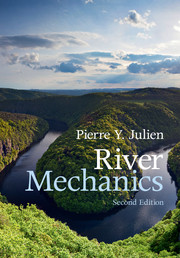Book contents
- River Mechanics
- Reviews
- River Mechanics
- Copyright page
- Dedication
- Contents
- Preface
- Notation
- 1 Physical Properties
- 2 Mechanics of Rivers
- 3 River Basins
- 4 River Basin Dynamics
- 5 Steady Flow in Rivers
- 6 Unsteady Flow in Rivers
- 7 Mathematical River Models
- 8 Hillslope and Revetment Stability
- 9 Riverbank Protection
- 10 River Equilibrium
- 11 River Dynamics
- 12 Physical River Models
- 13 Stream Restoration
- 14 River Engineering
- 15 River Estuaries
- Bibliography
- Index
- References
Bibliography
Published online by Cambridge University Press: 21 March 2018
- River Mechanics
- Reviews
- River Mechanics
- Copyright page
- Dedication
- Contents
- Preface
- Notation
- 1 Physical Properties
- 2 Mechanics of Rivers
- 3 River Basins
- 4 River Basin Dynamics
- 5 Steady Flow in Rivers
- 6 Unsteady Flow in Rivers
- 7 Mathematical River Models
- 8 Hillslope and Revetment Stability
- 9 Riverbank Protection
- 10 River Equilibrium
- 11 River Dynamics
- 12 Physical River Models
- 13 Stream Restoration
- 14 River Engineering
- 15 River Estuaries
- Bibliography
- Index
- References
- Type
- Chapter
- Information
- River Mechanics , pp. 453 - 492Publisher: Cambridge University PressPrint publication year: 2018



